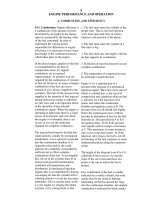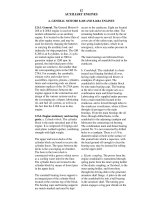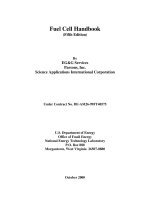Tài liệu GREEN SCHOOLS Guide docx
Bạn đang xem bản rút gọn của tài liệu. Xem và tải ngay bản đầy đủ của tài liệu tại đây (152.36 KB, 24 trang )
Funded by the British High Commission
GREEN SCHOOLS
Guide
The Green Schools Initiative is a joint project between Live & Learn
Environmental Education and the Ministry of Education.
This manual was prepared by:
Archana Narayan Sunila Prasad Christian Nielsen With contributions
from:
Madhukar Mudaliar (Water Audit)
Graphic Design and Desk Top Publishing
Susanna Xie - Xivine Studio Ltd., PO Box 12717, Suva, Fiji
Produced by:
Live & Learn Environmental Education
25 McGregor Rd.
Private Mail Bag
Suva - Fiji
Tel: 679 3315868
Fax: 679 3305868
e-mail: livelearntajis.com.fi
Funded by:
The British High Commission, Suva
Copyright 2000 Live & Learn Environmental Education
Permission is granted to duplicate materials for non-commercial, not-
profit educational purposes only provided acknowledgement is give.
All other rights are reserved.
WWHHYY
BBEECCOOMMEE
AA
GGRREEEENN
SSCCHHOOOOLL 11
AABBOOUUTT
TTHHIISS
GGUUIIDDEE 22
AAIIMM 22
CCRREEAATTIINNGG
AA
SSUUSSTTAAIINNAABBLLEE
SSCCHHOOOOLL
EENNVVIIRROONNMMEENNTT 33
SSTTEEPPSS
TTOO
FFOOLLLLOOWW 55
PPLLAANNNNIINNGG
AANNDD
PPRREEPPAARRAATTIIOONN 77
AACCTTIIVVIITTIIEESS
FFOORR
AANN
EENNVVIIRROONNMMEENNTT
AAUUDDIITT 1100
TTHHEE
BBIIGG
PPIICCTTUURREE 1155
CONTENTS
WHY
BECOME
A
GREEN
SCHOOL
Schools throughout the country face huge problems and
considerable costs in energy consumption, water usage and
solid waste disposal. Litter is not only a common problem in
school, but in the country as a whole.
Effective waste and litter education and conservation programs
in schools offer a range of important benefits. It raises aware-
ness among the students and teachers and gives a chance for
students to be actually involved in projects that could bring
about effective, hands-on learning experiences that could
enhance attitude transformation and value formation towards
the environment.
A best practice approach to Environmental Education involves
the integration of curriculum and environmental activities in
the school operation. It offers not only educational benefits,
but also cost-savings to the schools, and in some communities,
a promotion of the school.
This guide has been developed to help schools to:
• identify existing and potential sources of environmental
problems, and
• introduce cost-effective practices to minimise the impacts
of these problems on the environment.
All schools are invited and encouraged to join the Green
Schools Programme. You can find out about joining the group
from your local Green Schools Action Group, or can make direct
contact with the Live & Learn Environmental Education on the
address given in this Guide.
1
ABOUT
THIS
GUIDE
The need to conserve natural resources and the environmental
issues has received increasing attention in the last decade.
Many schools have tried to implement environmental education
strategies to promote environmental knowledge, skills and val-
ues among their students and community members.
This guide will build on some of these strategies and will help
schools to use resources more wisely.
It describes a range of activities to help students, teachers,
other staff and parents to:
• Conduct environmental audits to assess their schools
current environmental performance,
• Develop, implement and evaluate an environmental man-
agement plan to continually improve their schools
environmental performance.
This guide will make an effort to ensure that we have an edu-
cated and well-informed society on local, regional and interna-
tional environmental issues that have an impact on our envi-
ronmental and on our lives.
AIMS
The guide as a tool for environmental change aims to help
schools attain:
1. Wise energy use/conservation.
2. Wise material use.
3. Waste reduction and recycling.
2
4. Water conservation.
5. Knowledge on the consumption of biodiversity.
As a teaching resource, it aims to:
• Describe a range of school environmental activities suitable
for various year levels.
• Base environmental activities on an action research model,
encouraging students to research, plan and act on
environmental issues.
Why should School communities take action on
environmental issues?
The reasons why school communities should take action on
environmental issues are:
• To reduce environmental impacts caused by school activi-
ties.
• To create an environmental ethic among members of the
school community.
• To save money for the school, by reducing costs and
generating revenue.
3
CREATING
A
SUSTAINABLE
SCHOOL
ENVIRONMENT
Step 1. Establishing an Environmental School
Committee
In our collected endeavors to create a sustainable environment
the first step could be to establish an Environmental School
Council. This will encourage students to participate and claim
“ownership” of environmental problems that may be facing the
school.
As equality and democratic decision-making are two funda-
mentals in a sustainable environment the committee should
aim for equality in numbers in the following areas:
• Teachers and students
• Women, men, boys and girls
• Representation of all ethnic groups
This will contribute to a broad debate and will consider the
needs and concerns of everyone.
Students can elect their representative through a class ballot
and a representative from each class could be selected. At the
first committee meeting a Chairperson should be elected by the
committee to oversee and call the meetings.
It is important for the meetings to be focussed and
have an agenda in order to avoid wasting time.
On the first meeting the agenda could be the following:
AGENDA
1. Develop an environmental mission statement.
4
2. Identify desired goals with the Environmental School Audit
(e.g. Decrease wastes, start recycling, establish nursery).
3. Identify ways through which the school’s activities can link
with the community, the church and the elders.
4. Identify ways through which the school can link with other
groups and activities ( e.g. Keep Fiji Beautiful Association,
World Environment Day, Department of Environment, Anti-
dengue mosquito campaigns)
In order to make the committee effective it is
important to:
• Have regular meetings
• Have good communication between the committee and the
rest of the school and make the committee as inclusive as
possible.
• Involve parents in environmental initiatives
• Ensure all committee members take specific tasks
Step 2: Environmental School Audit
What is an environmental audit?
An environment audit is the process of assessing our attitudes
towards the environment. It is a process of monitoring and
measuring the use of resources.
The environment audit is done through self-reflection and
critical thinking on our actions and our use of resources. During
this process we have the opportunity to identify and investigate
problems that need to be challenged.
5
An environmental audit provides a baseline against which
improvements in environmental management can be
measured.
What outcomes can be expected?
An environmental school audit is valuable for the student,
teacher and the school. It will assist the teacher and the stu-
dents to identify problems in the school environment and more
specifically help identify resources used in the school
environment.
It provides the first step for the student to investigate solutions
to environmental problems such as waste, water and energy
conservation.
More importantly, an Environmental School Audit will encour-
age the students and the teachers to have a good look at their
own attitudes towards the school environment and their
participation.
In order for an Environmental School Audit to be effective,
honesty and openness are two critical factors.
Student Outcomes
Students who successfully complete the activities described in
the guide will:
• Identify resources used in their daily routine.
• Record and interpret data about the use of these
resources.
• Become more responsible in their use of these resources.
• Use teamwork to conserve these resources.
• Write, implement and evaluate a plan to use resources
wisely.
6









